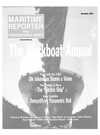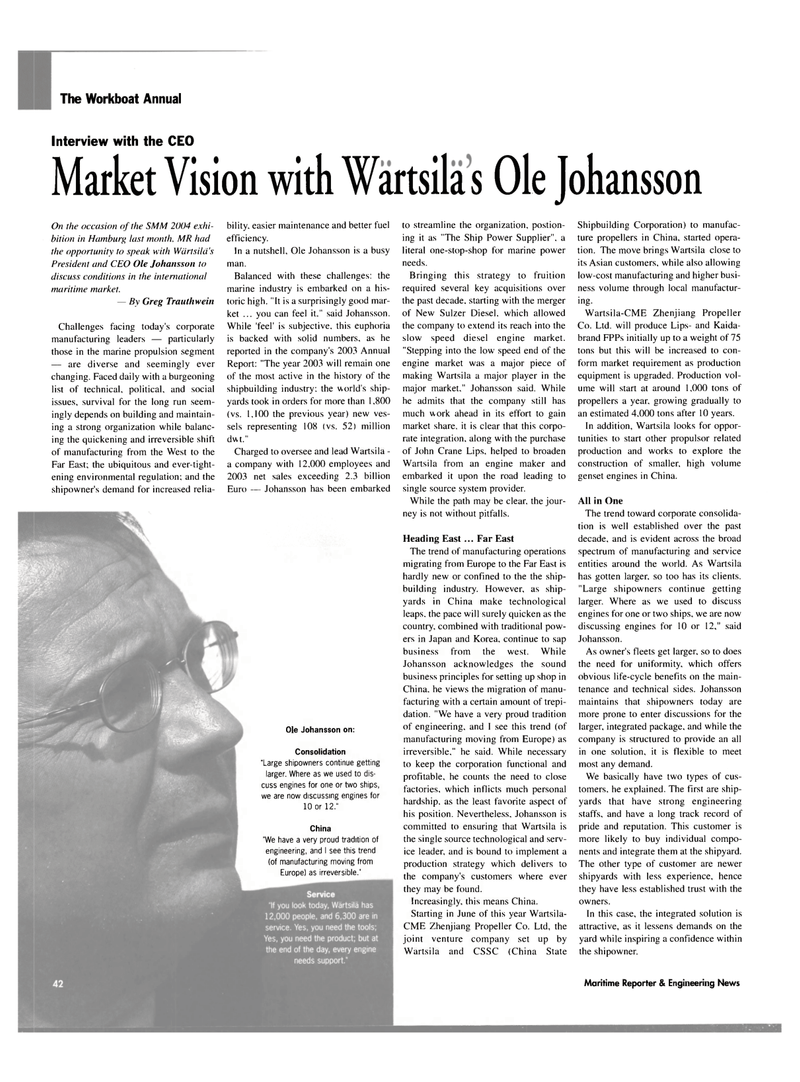
Page 40: of Maritime Reporter Magazine (November 2004)
The Workboat Annual
Read this page in Pdf, Flash or Html5 edition of November 2004 Maritime Reporter Magazine
The Workboat Annual
Interview with the CEO
Market Vision with Wartsila s Ole Johansson
On the occasion of the SMM 2004 exhi- bition in Hamburg last month. MR had the opportunity to speak with Wdrtsilci's
President and CEO Ole Johansson to discuss conditions in the international maritime market. — By Greg Trauthwein
Challenges facing today's corporate manufacturing leaders — particularly those in the marine propulsion segment — are diverse and seemingly ever changing. Faced daily with a burgeoning list of technical, political, and social issues, survival for the long run seem- ingly depends on building and maintain- ing a strong organization while balanc- ing the quickening and irreversible shift of manufacturing from the West to the
Far East; the ubiquitous and ever-tight- ening environmental regulation; and the shipowner's demand for increased relia- bility. easier maintenance and better fuel efficiency.
In a nutshell, Ole Johansson is a busy man.
Balanced with these challenges: the marine industry is embarked on a his- toric high. "It is a surprisingly good mar- ket ... you can feel it." said Johansson.
While 'feel' is subjective, this euphoria is backed with solid numbers, as he reported in the company's 2003 Annual
Report: "The year 2003 will remain one of the most active in the history of the shipbuilding industry: the world's ship- yards took in orders for more than 1,800 (vs. 1,100 the previous year) new ves- sels representing 108 (vs. 52) million dwt."
Charged to oversee and lead Wartsila - a company with 12.000 employees and 2003 net sales exceeding 2.3 billion
Euro — Johansson has been embarked to streamline the organization, postion- ing it as "The Ship Power Supplier", a literal one-stop-shop for marine power needs.
Bringing this strategy to fruition required several key acquisitions over the past decade, starting with the merger of New Sulzer Diesel, which allowed the company to extend its reach into the slow speed diesel engine market. "Stepping into the low speed end of the engine market was a major piece of making Wartsila a major player in the major market." Johansson said. While he admits that the company still has much work ahead in its effort to gain market share, it is clear that this corpo- rate integration, along w ith the purchase of John Crane Lips, helped to broaden
Wartsila from an engine maker and embarked it upon the road leading to single source system provider.
While the path may be clear, the jour- ney is not without pitfalls.
Heading East ... Far East
The trend of manufacturing operations migrating from Europe to the Far East is hardly new or confined to the the ship- building industry. However, as ship- yards in China make technological leaps, the pace will surely quicken as the country, combined with traditional pow- ers in Japan and Korea, continue to sap business from the west. While
Johansson acknowledges the sound business principles for setting up shop in
China, he views the migration of manu- facturing with a certain amount of trepi- dation. "We have a very proud tradition of engineering, and 1 see this trend (of manufacturing moving from Europe) as irreversible." he said. While necessary to keep the corporation functional and profitable, he counts the need to close factories, which inflicts much personal hardship, as the least favorite aspect of his position. Nevertheless, Johansson is committed to ensuring that Wartsila is the single source technological and serv- ice leader, and is bound to implement a production strategy which delivers to the company's customers where ever they may be found.
Increasingly, this means China.
Starting in June of this year Wartsila-
CME Zhenjiang Propeller Co. Ltd, the joint venture company set up by
Wartsila and CSSC (China State
Shipbuilding Corporation) to manufac- ture propellers in China, started opera- tion. The move brings Wartsila close to its Asian customers, while also allowing low-cost manufacturing and higher busi- ness volume through local manufactur- ing.
Wartsila-CME Zhenjiang Propeller
Co. Ltd. will produce Lips- and Kaida- brand FPPs initially up to a weight of 75 tons but this will be increased to con- form market requirement as production equipment is upgraded. Production vol- ume will start at around 1,000 tons of propellers a year, growing gradually to an estimated 4.000 tons after 10 years.
In addition, Wartsila looks for oppor- tunities to start other propulsor related production and works to explore the construction of smaller, high volume genset engines in China.
All in One
The trend toward corporate consolida- tion is well established over the past decade, and is evident across the broad spectrum of manufacturing and service entities around the world. As Wartsila has gotten larger, so too has its clients. "Large shipowners continue getting larger. Where as we used to discuss engines for one or two ships, we are now discussing engines for 10 or 12," said
Johansson.
As owner's fleets get larger, so to does the need for uniformity, which offers obvious life-cycle benefits on the main- tenance and technical sides. Johansson maintains that shipowners today are more prone to enter discussions for the larger, integrated package, and while the company is structured to provide an all in one solution, it is flexible to meet most any demand.
We basically have two types of cus- tomers, he explained. The first are ship- yards that have strong engineering staffs, and have a long track record of pride and reputation. This customer is more likely to buy individual compo- nents and integrate them at the shipyard.
The other type of customer are newer shipyards with less experience, hence they have less established trust with the owners.
In this case, the integrated solution is attractive, as it lessens demands on the yard while inspiring a confidence within the shipowner. 42 Maritime Reporter & Engineering News
Ole Johansson on:
Consolidation "Large shipowners continue getting larger. Where as we used to dis- cuss engines for one or two ships, we are now discussing engines for 10 or 12."
China "We have a very proud tradition of engineering, and I see this trend (of manufacturing moving from
Europe) as irreversible."

 39
39

 41
41
